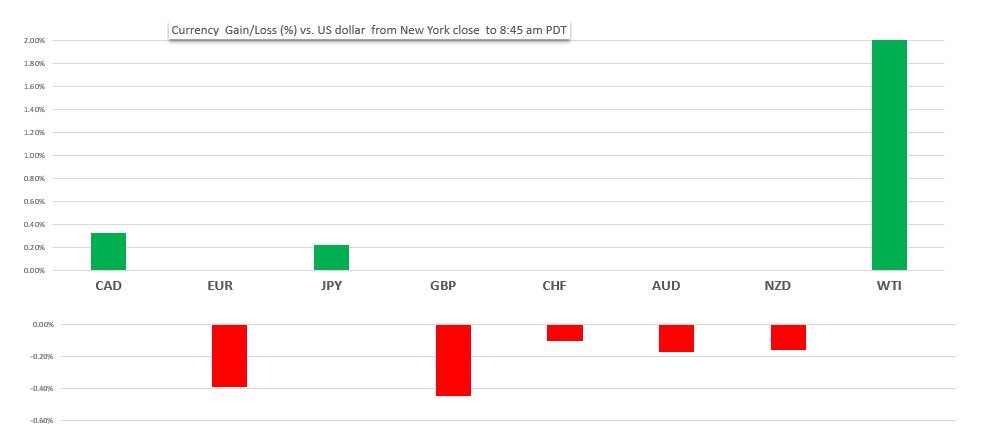
September 16, 2019
USDCAD Open (6:00 am EDT) 1.3258-62 Overnight Range 1.3210-1.3263
USDCAD plunged as oil prices surged. Saudi Arabia lost over 50% of its daily crude production following a drone strike on oil facilities. West Texas Intermediate (WTI) touched $63.15/barrel in early Asia, after closing in New York at $54.83/b, a gain of 15.2%. Prices retreated to $59.45/b in early Toronto trading due to a bit of profit taking and news that President Trump would release oil from the strategic petroleum reserve.
USDCAD gapped down from Friday’s 1.3287 close, touching 1.3210 in Asia before moving higher. The oil price spike added to recession fears which had already been stoked by the prolonged China/US trade war.
The US dollar finished last week on a mixed note and that is how it opened in New York. CAD, NZD, and JPY are a tad firmer, EUR and GBP a bit softer and CHF and AUD unchanged.
FX Market Snapshot
Change in Currency value vs the US dollar- NY close to 5:45 am PDT

EURUSD traded erratically. Traders are still digesting the results of last week’s ECB policy meeting, which managed to overshadow more recent geopolitical issues. EURUSD chopped about in a 1.1043-1.1085 range overnight and opened at session lows in Toronto
GBPUSD rallied hard on Friday, in part because of hopes the UK would avoid a “no-deal Brexit.” Traders had second thoughts to start the week and prices traded down from 1.2501 to 1.2427. Prime Minister Boris Johnson is adamant that the UK will leave the EU on October 31 and he won’t accept any extensions to the deadline.
The USDJPY rally from the beginning of September ended when uptrend line support at 108.00, was broken. The drone attack on Saudi Arabian oil fields sparked safe-haven currency demand. A drop in US 10 year Treasury yields from 1.901% to 1.822% also weighed on prices
Oil price action may have been the star of the show, but China data and UK politics played supporting roles. China August Retail Sales, (Actual 7.5% y/y vs forecast 7.9% y/y and July 7.6%y/y) and Industrial Production, (Actual 4.4% y/y vs forecast 5.2%) were weaker than expected. Chinese Premier Li Keqiang said it “is difficult” for China’s economy to grow at 6% or more, and that it was facing downward pressure. The data had limited impact because markets are still on a high from last week’s positive US/China trade developments.
AUDUSD and NZDUSD gapped lower at the open and then recouped those losses by the Toronto open. The Reserve Bank of Australia policy meeting minutes from the September 3 meeting are due tomorrow. They aren’t expected to provide traders with any new insight. NZDUSD traders are looking ahead to Thursday’s GDP data.
Today’s US and Canadian economic releases are second-tier and not a trading factor.
USDCAD Technical View
The intraday USDCAD technicals are bullish above 1.3220, looking for a test and break of resistance at 1.3280 to extend gains to 1.3340. A break below 1.3220 targets 1.3170. Longer term, Fibonacci retracement from May 30 peak to July low, suggests a break above 1.3290 opens door to retest of 1.3433. Today’s Range 1.3180-1.3280.
Chart: USDCAD 1 hour






